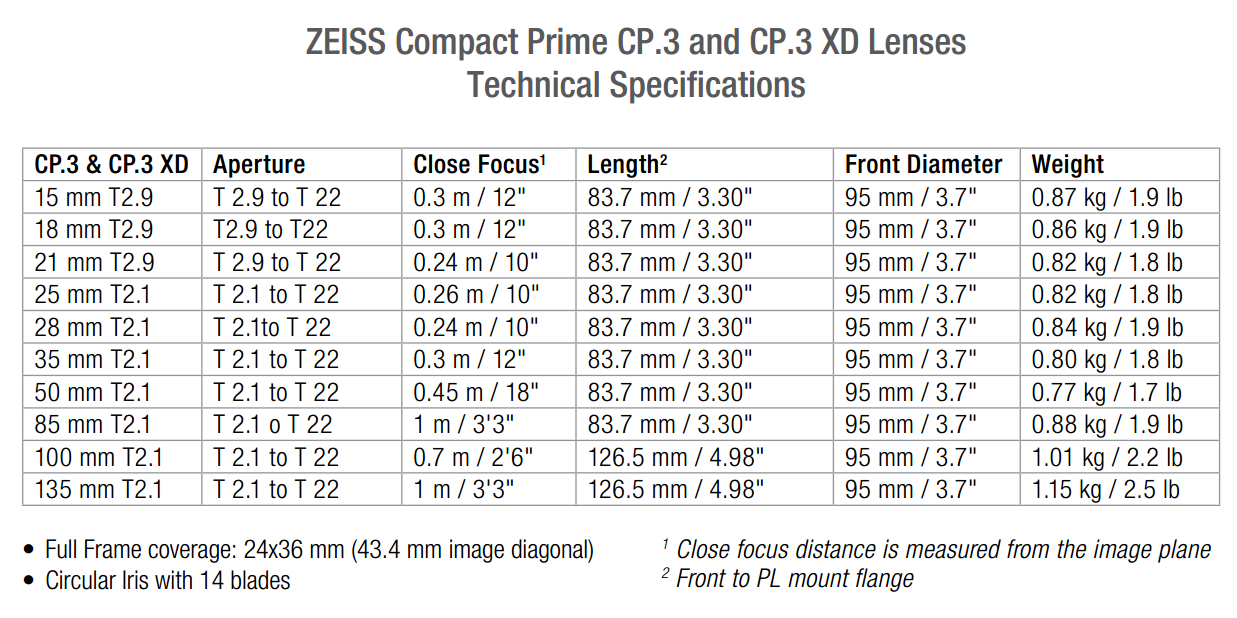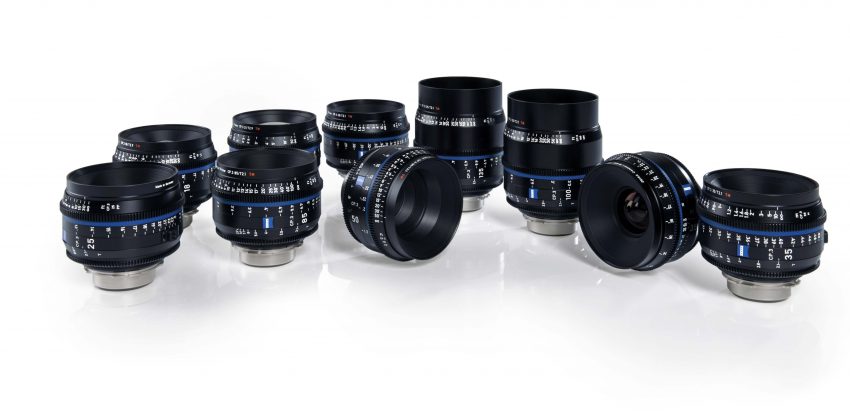Read the full article in FDTimes April Issue 81-82 going online Monday at 12 noon EST.
Imagine a series of lenses you can customize. It’s a cinematographic dream to create unique and signature looks far from the competitive crowd. What if you could tweak some of the characteristics of a lens in real time, on set or on location? Now you can, as ZEISS introduces 10 new CP.3 Compact Prime Lenses. There are 6 big reasons the new ZEISS CP.3 prime lenses resonate: Full Frame, smaller size, custom looks, ZEISS eXtended Data (lens metadata), interchangeable mounts and smoother focus.
Custom Looks. This is the breakthrough moment when metadata for cine lenses becomes democratized and prevalent. It’s an “aha” moment as a previously perplexing conception becomes comprehensible. Lens data is much more than contacts and connectors and rheostatic sliders that send focus, iris or zoom barrel settings to a recorder. It requires an easy, seamless, “killer app” on the recording and post side—which has been absent up to now. Working with Pomfort and Ambient, ZEISS joined the /i Technology industry group developed by Cooke and added their own extended data algorithms for distortion mapping and shading. Not only can you correct lens aberrations, but now you can also enhance it, add distortion, increase darkening at the edges, and so on.
Lens Data. ZEISS CP.3 lenses come with or without XD eXtended Data. The difference in price is much less than the buyer’s remorse I think you will suffer if you don’t spring for it. It would be like buying an iPhone without a data plan. As Sherlock Holmes said, “It is a capital mistake to theorize before one has data.” The future belongs to those who can manage their data. More on this in a minute.
Full Frame. All the CP.3 primes, from 15 to 135 mm, cover Full Frame format—24×36 mm (43.4 mm image diagonal). That provides future-proof coverage from Full Frame all the way down to current Super35, in focal lengths that are useful and familiar in both formats. While 15 mm is quite wide in S35, it is extremely wide and quite remarkable in Full Frame.
Smaller Size. The entire set of 10 CP.3 primes have a front diameter of 95 mm. This is good. Cameras have become smaller and lighter. Meanwhile, expanded focus scales aren’t as important as they were 7 years ago. That’s because many, if not most, focus pullers are using wireless controls that can expand focus scales electronically on the hand unit. So, the large 114 mm front diameters of ZEISS CP.2s that enabled easier mechanical follow focus are less compelling than the need for smaller, lighter, more compact primes. CP.3 lenses are about the size of current Ultra Primes—but they cover Full Frame.
Interchangeable Lens Mounts. This is essentially the third iteration of ZEISS Compact Primes. They have been the most widely distributed cine lenses in history—with more than 30,00 units sold. The original Compact Primes were introduced exactly eight years ago, at NAB 2009. They came with PL mounts only.
Only a few months earlier (November 2008), Canon had introducted their Full Frame 5D Mark II and Panasonic launched Lumix G1 (MFT). It’s amusing to revisit FDT’s “misunderestimation” at the time: “Compact Primes cover Super 35 and, as an added bonus, also cover Full Frame still format. I hear grinding wheels starting up in machine shops: maybe modified DSLR cameras with PL mounts are in our future…” What was I thinking? The future was then. DPs like Pawel Achtel attacked their cameras with Dremel tools. FGV Schmidle modified 5D Mark II cameras with PL mounts. Illya Friedman, Matthias Uhlig, P+S Technik, Denz, I/BE Optics and others built PL to EF and MFT mount adapters.
But there was another way—interchangeability rather than retrofitting. Like clockwork, a year later at NAB 2010, ZEISS introduced the CP.2 series with user-interchangeable PL, EF and F mounts. E and MFT would come later. Coverage was Full Frame 24×36 mm like the original Companct Primes. Now you could preserve your investment in glass because they were agnostic to mounts and would fit almost any camera.
Take 3 is often the best—and now ZEISS introduced the CP.3 series—lighter, smaller, refined, data-enabled, and also with lens mounts you can easily interchange during prep or on location in just a few minutes. Even the lens cap has been redesigned.
Smoother Focus. Another major reason to like the ZEISS CP.3 lens set is the new mechanical design of the focus mechanism. It is much smoother and gentler to the touch than earlier helical threaded focus barrels. It doesn’t get stiffer as the temperature drops. Much less torque is required, so you can use smaller, lighter lens motors. This was the kind of focus feel previously associated with cams, which are great but can tend to make the lens larger and heavier. Reducing the friction took several years, and Helmut Lehnhof explained that it was a long process of choosing new materials and manufacturing techniques.
Design Philosophy. In Oberkochen a couple of weeks ago at ZEISS headquarters, Christophe Casenave, Senior Product Manager, explained the evolution of the CP.3 series. It began several years ago with a look at some of the areas where the CP.2 lenses could be improved. The 18mm did not cover Full Frame. There were 4 different body lengths and 3 different maximum apertures in the CP.2 set. The focus was stiff. The 114 mm front diameter was large—the same as Master Primes.
Christophe said, “The CP.2 lenses created a market that didn’t even exist before them. Their ‘playground’ was the growing number of cine cameras that were getting smaller: RED, Blackmagic, Canon, Sony, Panasonic and ARRI Alexa Mini. What if we could make Compact Primes smaller—the size of Ultra Primes, with a more modern optical design, newer coatings, and still cover Full Frame (which the Ultra Primes do not)?”
The intended user groups range from the ever-growing independent filmmaker to medium-budget feature, TV, corporate, documentary and commercial production markets.
XD eXtended Data. ZEISS CP.3 lenses equipped with XD eXtended Data have four gold-plated /i Technology contacts at the 12 o’clock position in the PL mount and also a 4-pin Lemo connector protruding from the fixed barrel between the iris and focus rings.
What is lens metadata, /i Techology and why might it be so important? Most of us are familiar with Photoshop’s FILE – FILE INFO Command for still images. This gives us helpful information about the camera, lens, focal length, exposure time, aperture, ISO, image size, etc.
In cine production, lens data can be used to display focus, iris and zoom information. On Transvideo monitors, the AC gets an instant depth of field calculation. A script supervisor with a similar monitor displaying lens focal length and aperture wouldn’t have to annoyingly bring the ‘roll-camera-ready-and…’ routine to a grinding halt by shouting across the set to the AC, “What’s your millimeter?”
Hopefully the number of VFX and post people using lens metadata for motion tracking, match moving and CGI is growing greater than the population of Pitcairn Island. But it has been painfully slow to catch on. Why?
Christophe Casenave explained lens metadata in terms familiar to FDTimes, with a food analogy. “It’s like cooking. If you are on a big-budget Hollywood production, that is like a 3-star Michelin restaurant. You can pay someone to cut the onions, to manage your metadata. But if you have a small restaurant in a small village, you cannot afford to hire an extra person just to cut onions. The same is true on an independent production where the DP is often the DIT as well. So you buy a machine to do the work.”
The “machines” that make metadata practical and popular are a combined effort. ZEISS became an /i Technology partner. They developed their own XD eXended Data set for lens distortion parameters and lens shading characteristics (darkening toward the edges of frame) for every focus distance and T-stop.
The “killer app” machines came about from a cooperation between ZEISS, Ambient Recording and Pomfort. How convenient. They are all within a 180 km radius around Munich. Ambient is famous for timecode systems, slates, master clocks and metadata communication. Their new Master Lockit Plus will record ZEISS XD data internally as well as pass it through to Pomfort’s latest LiveGrade Pro running on set.
The latest LiveGrade Pro not only displays lens data, but also has sliders that let you immediately adjust shading and distortion.
With ZEISS CP.3 XD primes equipped with eXtended Data, you will be able to instantly customize and tweak how the lens looks and behaves from the DIT cart. Traditionally, lens data has been used by a post house to correct distortion, match it with background plates or expedite match moving. But now, you can even enhance distortion on set—or correct it. The same goes for shading.
A dramatic close-up on a leading lady might be embellished with a slight darkening around the edges to draw the viewer in. An architecturally rectilinear shot might become more interesting with barrel distortion of the verticals. And oh, those beautifully distended spherical bokehs now rendered almost anamorphically oval. All this can be created with XD.
/i and XD. ZEISS joined the /i Technology industry group and added their own extended data algorithms for distortion mapping and shading. /i Technology is an open standard developed by Cooke Optics. (tiny.cc/itech) There are several parts to /i. The open-standard (public) core includes lens manufacturer, name, type, serial number, focus distance, T-stop, depth of field, and entrance pupil.
In addition to the core component of /i, there is also a proprietary (extended) area. It’s defined in a User Manual (tiny.cc/i-user).
Obviously, there are certain things a manufacturer would not want to share with others and keep private between their lenses and their users. This is where a manufacturer can store lens characteristics like distortion maps, shading information and so on. And this is the area that ZEISS refers to as XD eXtended technology. ZEISS XD is frame-accurate and precise to 1 mm of focus and 1/10 of a T-Stop.
I think ZEISS CP.3 XD eXtended Data has a great future because it’s already a cooperative, shared standard. It is compatible with cameras, accessories and software that support /i Technology. Cameras with PL mounts that work with XD include ARRI Alexa Mini with SUP 7, RED DSCM2, Sony F55 and Blackmagic URSA Mini Pro. Wireless remote control systems include Preston FIZ HU3, cmotion cvolution, and ARI WCU-4. Transvideo supports it with their LensReader in CinemonitorHD Evolution.
CP.3 without eXtended Data should ship in June. CP.3 XD (with eXtended Data) ship in September. Decide wisely. You will not be able to upgrade a CP.3 to CP.3 XD. www.zeiss.com/cine/cp3
CP.3 from $ 4390 / € 3500. CP.3 XD from $ 5790 / € 5000
CP.3 5-Lens Set from $ 19.316 / € 15400
CP.3 XD 5-Lens Set from $ 25.476 / € 22000







